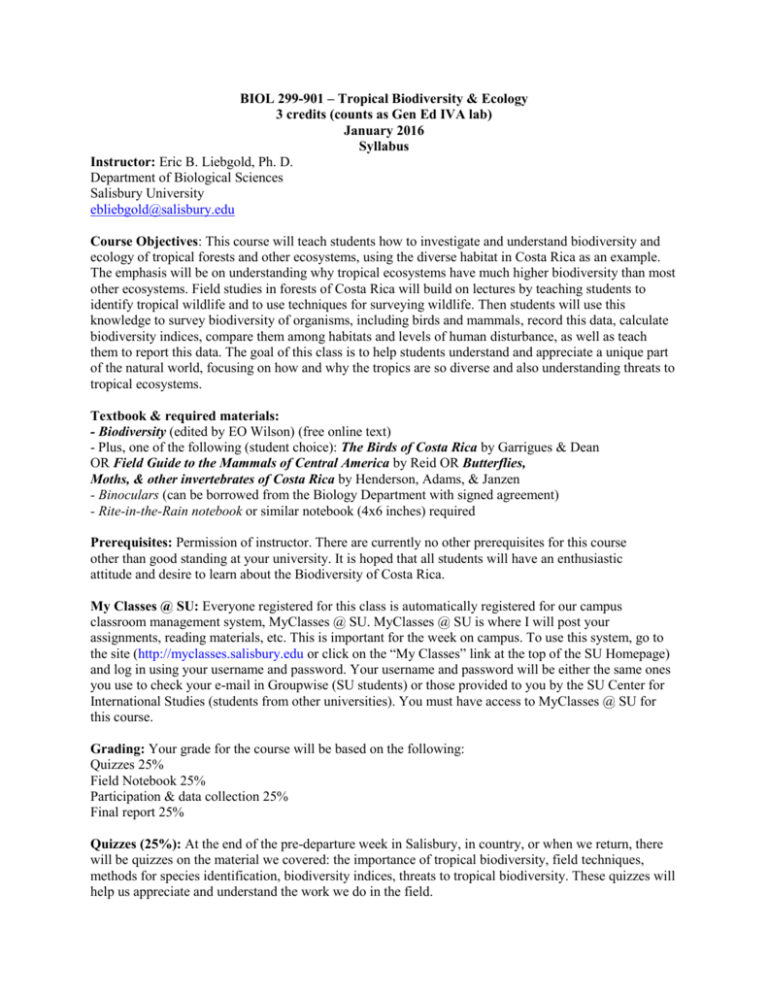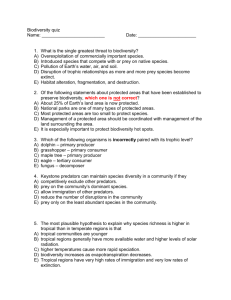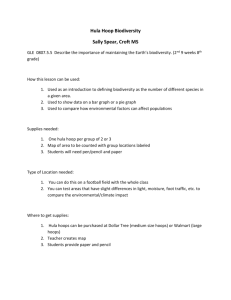liebgold_biol_299
advertisement

BIOL 299-901 – Tropical Biodiversity & Ecology 3 credits (counts as Gen Ed IVA lab) January 2016 Syllabus Instructor: Eric B. Liebgold, Ph. D. Department of Biological Sciences Salisbury University ebliebgold@salisbury.edu Course Objectives: This course will teach students how to investigate and understand biodiversity and ecology of tropical forests and other ecosystems, using the diverse habitat in Costa Rica as an example. The emphasis will be on understanding why tropical ecosystems have much higher biodiversity than most other ecosystems. Field studies in forests of Costa Rica will build on lectures by teaching students to identify tropical wildlife and to use techniques for surveying wildlife. Then students will use this knowledge to survey biodiversity of organisms, including birds and mammals, record this data, calculate biodiversity indices, compare them among habitats and levels of human disturbance, as well as teach them to report this data. The goal of this class is to help students understand and appreciate a unique part of the natural world, focusing on how and why the tropics are so diverse and also understanding threats to tropical ecosystems. Textbook & required materials: - Biodiversity (edited by EO Wilson) (free online text) - Plus, one of the following (student choice): The Birds of Costa Rica by Garrigues & Dean OR Field Guide to the Mammals of Central America by Reid OR Butterflies, Moths, & other invertebrates of Costa Rica by Henderson, Adams, & Janzen - Binoculars (can be borrowed from the Biology Department with signed agreement) - Rite-in-the-Rain notebook or similar notebook (4x6 inches) required Prerequisites: Permission of instructor. There are currently no other prerequisites for this course other than good standing at your university. It is hoped that all students will have an enthusiastic attitude and desire to learn about the Biodiversity of Costa Rica. My Classes @ SU: Everyone registered for this class is automatically registered for our campus classroom management system, MyClasses @ SU. MyClasses @ SU is where I will post your assignments, reading materials, etc. This is important for the week on campus. To use this system, go to the site (http://myclasses.salisbury.edu or click on the “My Classes” link at the top of the SU Homepage) and log in using your username and password. Your username and password will be either the same ones you use to check your e-mail in Groupwise (SU students) or those provided to you by the SU Center for International Studies (students from other universities). You must have access to MyClasses @ SU for this course. Grading: Your grade for the course will be based on the following: Quizzes 25% Field Notebook 25% Participation & data collection 25% Final report 25% Quizzes (25%): At the end of the pre-departure week in Salisbury, in country, or when we return, there will be quizzes on the material we covered: the importance of tropical biodiversity, field techniques, methods for species identification, biodiversity indices, threats to tropical biodiversity. These quizzes will help us appreciate and understand the work we do in the field. Field Notebook (25%): All students will be required to maintain a Field Notebook. Rite-in-the-rain notebook or other 4x6 inch notebook is required. Prior to departure, we will go over what is required for collecting data (biological observations, weather, and other parameters) in a field notebook. The goal is to create a semi-permanent record of your observations and collect data while on the trip. Reflections on the day’s activities will likewise be required. Participation & data collection (25%): Participation in in-class discussions of selected chapters from the text and articles read in class goes towards this grade as does participation in field activities in Costa Rica. Data collection on datasheets in groups also counts towards this grade. Final report (25%): After we return from Costa Rica, students will use their knowledge of tropical biodiversity (notes from pre-trip and in trip lectures and discussion), field notebooks, and data collection and analysis (calculation of biodiversity indices), to type up a report comparing biodiversity of different tropical forest habitats (e.g. lowland rainforest vs cloud forest) or comparing biodiversity of different types of organisms (e.g. birds vs insects) using the scientific format (introduction, methods, results, discussion). Writing across the curriculum: At the University Writing Center at Herb’s Place (Guerrieri University Center, Room 206), trained consultants are ready to help you at any stage of the writing process. All undergraduates are encouraged to make use of this important student service. For more information visit the writing center or its website at http://www.salisbury.edu/uwc/. Finally, student misconduct (cheating and plagiarism) will not be tolerated. The University guidelines concerning academic honesty, as explained in the Undergraduate Catalogue and Student Handbook, will be strictly enforced. Ignorance of what constitutes student misconduct is not an excuse. For more information on what constitutes student misconduct, please visit the instructor or see: If you are unsure of what comprises plagiarism, http://www.lib.usm.edu/legacy/plag/whatisplag.php or http://www.salisbury.edu/library/plagiarism/student.html provides an explanation and some examples or contact the instructor. Any student found engaging in academic misconduct (cheating, plagiarizing, etc…) will be given a 0 for the assignment, reported to the appropriate University authorities, and dealt with as described in the Catalog. Some circumstances may involve receiving an F and expulsion from the course. In our often highly competitive campus and classroom environment, our desire to perform well so as to please ourselves, our parents, and others can make it very tempting to engage in these distasteful and dishonorable practices. Resist the temptation and keep your personal integrity intact. Course Agenda: At SU: Day 1-3: Lectures, discussions, activities calculating biodiversity indices, and tutorials on use of binoculars and wildlife field identification. Day 4: Quiz and final preparations Trip to Costa Rica: Day 1: Travel to Costa Rica. Initial introduction to the country, its people & culture, and tropical environments. Overnight partway to Tortuguero National Park (Caribbean lowland rainforest). Day 2: Survey for wildlife on boat ride to Torteguero National Park (Caribbean lowland rainforest) including birds, sloths, monkeys, turtles, and crocodiles. Set up camera traps and insect traps. Scientific literature discussion on tropical species diversity. Overnight in Torteguero. Day 3: Boat wildlife tour through the Tortuguero Canals. Hiking and wildlife surveys through Tortuguero National Park. Take down insect traps. Overnight in Torteguero. Day 4: Remove camera traps. Transfer to Sarapiquí region. Chocolate Tour and wildlife observations at Tirimbina Biological. Data management and calculation of species diversity indices. Overnight in Sarapiqui area. Day 5: Wildlife surveys and ecological research at La Selva Biological Station, one of the most important tropical research stations and home to over 400 bird species. Discussion of current and previous research at La Selva. Overnight in Sarapiqui area. Day 6: Transfer to Arenal region. Wildlife surveys by kayak on Lake Arenal. Overnight in Lake Arenal area. Day 7: Transfer to Monteverde Cloud Forest. Surveys of forest canopy on Canopy Tour. Set up camera and insect traps. Scientific literature discussion on the impacts of ecotourism on biodiversity. Overnight in Monteverde. Day 8: Hiking and wildlife surveys in the Monteverde Reserve (early morning and late afternoon) looking for diverse birds and butterflies. Take down insect traps. Graphing rank-abundance curves. Night hike for observing difficulties in assessing diversity of nocturnal wildlife. Overnight in Monteverde. Day 9: Transfer to Palo Verde National Park. Use boats and hiking to survey wildlife of a grassland/lowland dry forest. Day 10: Continue wildlife surveys in Pacific lowland rainforest. Compare and contrast lowland and upland habitats based on graphs and biodiversity indices. Day 11: Fly back to USA. Field notebooks due. 2 days later: Final reports due.






